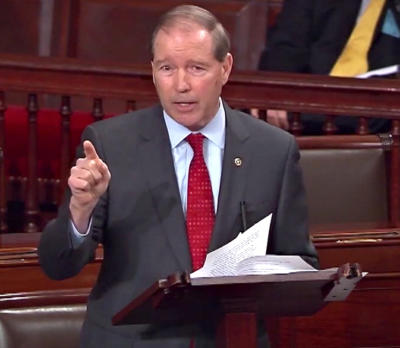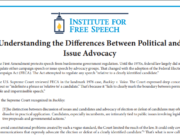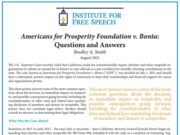The Senate Judiciary Committee will soon hold a hearing on S.J. Res. 19, a constitutional amendment to restrict First Amendment rights proposed by Senator Tom Udall (D-NM) and sponsored by 41 other senators. Senate Democratic leaders have indicated they plan to bring the measure to a vote on the Senate floor. This analysis examines the constitutional amendment proposal and explains its many glaring issues.
What does the amendment do?
The Udall Amendment is not the same amendment supported by Justice John Paul Stevens, although the basic thrust of the two texts is the same.[1] The Udall proposal is designed to overturn essentially all of the Supreme Court’s constitutional jurisprudence going back to the 1976 (and near-unanimous) decision in Buckley v. Valeo.[2] Even given this ambitious intention, however, many of the practical effects of the amendment cannot be reliably predicted.
Section 1
The first provision states that “[t]o advance the fundamental principle of political equality for all, and to protect the integrity of the legislative and electoral processes, Congress shall have power to regulate the raising and spending of money and in-kind equivalents with respect to Federal elections, including through setting limits on—(1) the amount of contributions to candidates for nomination to, or for election to, Federal office; and (2) the amount of funds that may be spent by, in support of, or in opposition to such candidates.”[3]
This section begins with a constitutional rarity: a preamble.[4] Consequently, while it grants Congress the power to limit contributions and expenditures concerning candidates, it also justifies Congress having this power in order to “advance the fundamental principle of political equality for all, and to protect the integrity of the legislative and electoral processes.” This may suggest that Congress may legislate in this area only for this purpose and not others, and that Congress must somehow evidence this subjective intention when passing laws. How two deliberative bodies containing hundreds of voting members can meet such a subjective-intent test is unclear and was probably not considered by the drafters.
The larger issue is that, under our present system, it is unconstitutional to strengthen the voices of some individuals at the expense of others. The Court has explained that “equalizing campaign resources ‘might serve not to equalize the opportunities of all candidates, but to handicap a candidate who lack[s] substantial name recognition or exposure of his views before the start of the campaign.’”[5]
Because of this, efforts to ‘level the playing field’ do “not serve ‘a legitimate government objective,’ let alone a compelling one.”[6] Under the Udall regime, this would be flipped on its head – government efforts to equalize campaign resources might have to be defended on the grounds of “advanc[ing]…political equality for all,” or “to protect the integrity of the legislative and electoral processes.”
Second, it grants broad power to Congress to regulate spending in order to “protect the integrity of the legislative and electoral processes.” Notably, the amendment does not use the familiar phrase “corruption or the appearance of corruption” – the present permissible rationale for the government’s restriction of campaign contributions.[7]
This could represent a sea change, because under Buckley and its progeny, “the Government’s interest in preventing the appearance of corruption is equally confined to the appearance of quid pro quo corruption…[thus], the Government may not seek to limit the appearance of mere influence or access.”[8] “The fact that speakers may have influence over or access to elected officials does not mean that those officials are corrupt.”[9] Under the Udall amendment, it may be possible to regulate speech on a generic favoritism or influence theory. No one can say with certainty what such a theory would look like, except that it would be broader and less defined than the law at present.
In particular, it invites Congress to discriminate amongst entities that have differing levels of “influence,” based upon public perception, instead of any kind of hard data. Judges are routinely asked to defer to Congress in this area. Under this amendment, they may be asked to defer to Congress’s determination that corporations, but not unions, may contribute to candidates,[10] or that nonprofit corporations like the Sierra Club may be banned from mentioning candidates for office when discussing environmental issues, or that family members of prominent media personalities may be regulated differently from less-connected Americans. A corruption standard helps prevent such gamesmanship; an “integrity” or “political equality” standard would not.
Next, the amendment permits “Congress…to regulate the raising and spending of money and in-kind equivalents with respect to Federal elections.” What qualifies as an “in-kind equivalent” is unclear, but this would likely be read to permissibly restrict, for instance, a person from volunteering for a campaign.[11]
The text then includes two examples of how Congress may advance equality and integrity. A close reading of the preamble shows that these are just that: examples. Congress’s power to regulate in the area of speech is clearly broader under this text, as the preamble uses the phrase “including through setting limits on [“contributions” and funds “spent” on candidates]. Consequently, it is impossible to fairly read this amendment as narrowly targeted to spending in elections. While perhaps intended for rhetorical flourish and popular consumption, the broad grant of power in the beginning of the amendment is precisely that: a broad grant. It is not apparent that anyone has seriously considered the dangers posed by allowing Congress, under the rhetorical cover of opposing Citizens United, to broadly regulate speech.
Nevertheless, the examples given are likely intended to be central to the operation of the amendment, although that is not the ultimate effect of the chosen language.
First, Congress may limit contribution amounts directly to candidates. Under the present law, which has been developed in the absence of any explicit enabling constitutional provision to enact such limits, most limits on contributions given directly to candidates have been upheld. However, this section could plausibly be read to re-establish the aggregate limits regime overturned by McCutcheon v. FEC,[12] or any contribution limit at all, including the limits found unconstitutionally low in Randall v. Sorrell. As Justice Breyer’s opinion noted, “contribution limits that are too low can also harm the electoral process by preventing challengers from mounting effective campaigns against incumbent officeholders, thereby reducing democratic accountability.”[13] Breyer also noted that the limits at issue were so low that “a gubernatorial campaign volunteer who makes four or five round trips driving across the State performing volunteer activities coordinated with the campaign can find that he or she is near, or has surpassed, the contribution limit. So too will a volunteer who offers a campaign the use of her house along with coffee and doughnuts for a few dozen neighbors to meet the candidate, say, two or three times during a campaign.”[14]
Finally, section 1 permits limits on the “amount of funds that may be spent by, in support of, or in opposition to” candidate campaigns. This would permit Congress to cap spending by candidates at a specific amount. This power is explicitly extended to speech “in support of, or in opposition to” candidates – essentially allowing Congress to limit all speech about candidates.
This raises a host of unanswered questions. Would spending by independent groups lower the amount that could be spent by a candidate? What would be included in “support of” or “opposition to” a candidate? Who would decide what is support and what is phony support that highlights an unpopular stand by a candidate? Given the broad grant of authority over political speech, “support of” or “opposition to” a candidate could constitute virtually all speech about politics.
For example, in June of 2004, the American Civil Liberties Union (ACLU) ran an advertisement featuring former Navy Judge Advocate General Real Admiral John D. Hutson (ret.) asking “How can we fight to uphold the rule of law if we break the rules ourselves?” and asserted that “we are conducting the war against terrorism in a manner that is inimical to those values of freedom of justice.”[15] The ad did not mention President Bush, then a candidate for re-election, whose campaign largely focused on the President’s conduct of the War on Terror. The New York Times nonetheless characterized the ad as a negative ad urging Americans to vote Bush out of office.[16] The Buckley Court explicitly rejected a reading of the Federal Election Campaign Act that allowed limits on independent speech precisely because it “would provide no security for free discussion.”[17]
Under the Udall regime, voter guides, issue advertisements, church bulletins (a sermon on marriage or abortion could be deemed inherently “political,” and local candidates may well be identified with one or another position), and the like could all be limited – or even banned – if their funders might violate the “fundamental principle of political equality” merely by being organized as a corporation or labor union. This amendment would provide a breathtaking amount of power to congressional incumbents to set limits on speech about policy or campaigns, effectively making the First Amendment a dead letter for speech.
Section 2
Section 2 merely applies the language of section 1 to the states, with all of the concerns that apply there. Specifically, section 2 could resuscitate Arizona’s Rube Goldberg equalization scheme, which was struck down by the Supreme Court in 2011. That system, where monies spent by privately funded candidates and outside groups could provide additional funding to a publicly funded candidate, was eliminated on the grounds that it served to “level the playing field.”[18] Under the Udall amendment, such a system could survive constitutional scrutiny.
Section 3
The third section of the amendment provides that “[n]othing in this article shall be construed to grant Congress the power to abridge the freedom of the press.” Presumably, this is intended to serve as a “media exemption” – a provision often included in campaign finance statutes to preserve the rights of The New York Times editorial board and Fox News’s Sean Hannity to endorse and campaign for candidates.
But the scope of such an exemption is unclear. The right to a free press does not extend a specific speech right to media corporations that other Americans do not have. The free press clause is merely a natural corollary to the free speech clause, it protects the right to publish and distribute the written word.
The Supreme Court has “consistently rejected the proposition that the institutional press has any constitutional privilege beyond that of other speakers.”[19] And even in the event that “the press” did confer a separate sanction for certain speech, the Supreme Court in 2010 noted that “[w]ith the advent of the Internet and the decline of print and broadcast media, moreover, the line between the media and others who wish to comment on political and social issues becomes far more blurred.”[20]
When Justice Stevens was asked to explain what was and was not press under his proposed amendment, not even he could answer.[21]
This uncertainty over who qualifies for the media exemption may not faze the regulators, however, who tend to favor established players at the expense of newcomers. The Federal Election Commission, for example, has traditionally applied the media exemption by asking, “First . . . whether the entity engaging in the activity is a press or media entity.”[22] In other words, in order to qualify as a media entity, a speaker must first be a media entity. The Udall amendment’s special exemption for the press would further entrench this model of circular reasoning and preferential treatment for certain speakers over others.
Conclusion
The Udall amendment would rebuke four decades of campaign finance jurisprudence from the Supreme Court and greatly reduce the quantity of debate in this country. The amendment could be read as a broad grant to Congress to regulate virtually all political speech and association, and fundamentally miscomprehends the free press clause. It is a rhetorical document, introduced during an election year, which highlights the difficulty in tampering with the First Amendment.
You can read the full analysis here.
[1] Adam Liptak, “Justice Stevens Suggests Solution for ‘Giant Step in the Wrong Direction,’” The New York Times. Retrieved on May 28, 2014. Available at: http://www.nytimes.com/2014/04/22/us/politics/justice-stevenss-prescription-for-giant-step-in-wrong-direction.html?_r=0 (May 26, 2014).
[2] “Udall Constitutional Amendment on Campaign Finance to get Senate Floor Vote,” Office of U.S. Senator Tom Udall. Retrieved on May 28, 2014. Available at: http://www.tomudall.senate.gov/?p=press_release&id=1637 (April 30, 2014) (“Udall introduced his constitutional amendment…last June to reverse the Court’s 1976 Buckley v. Valeo decision, which held that restricting independent campaign expenditures violates the First Amendment right to free speech.”)
[3] “S. J. Res. 19 (113th Congress, 1st Session),” United States Government Printing Office. Retrieved on May 28, 2014. Available at: http://www.gpo.gov/fdsys/pkg/BILLS-113sjres19is/pdf/BILLS-113sjres19is.pdf (June 18, 2013).
[4] While the Constitution itself famously begins with a preamble written in the voice of “we the people,” only one other portion includes a preamble describing the purpose of governmental authority: the Second Amendment. U.S. Const., amend. II. Of course, in that case, a great deal of disagreement and difficulty stems from the interaction between the preamble’s invocation of “a well regulated militia” and the final language stating that “the right to keep and bear arms shall not be infringed.” See District of Columbia v. Heller, 554 U.S. 570 at 577 (2000) (“The Second Amendment is naturally divided into two parts: its prefatory clause and its operative clause. The former does not limit the latter grammatically, but rather announces a purpose.”), compare with 554 U.S. at 643 (Stevens, J., dissenting) (“The Court today tries to denigrate the importance of this [preambulatory] clause…That is not how this Court ordinarily reads such texts, and it is not how the preamble would have been viewed at the time the Amendment was adopted.”); see also Akhil Reed Amar, “Second Thought,” The New Republic. Retrieved on May 28, 2014. Available at: http://www.newrepublic.com/article/politics/second-thoughts (July 12, 1999). (“This curious syntax has perplexed most modern readers: How do the two main clauses with different subject-nouns fit together? Do these words guarantee a right of militias, as the first clause seems to suggest, or a right of people, as the second clause seems to say?”). This experience ought to be sufficient to discourage Sen. Udall’s style of constitutional draftsmanship.
[5] Arizona Free Enterprise Club’s Freedom Club PAC v. Bennett, 131 S. Ct. 2806, 2826 (2011) (quoting Buckley v. Valeo, 424 U.S. 1, 56 (1976)).
[6] Id. at 2825 (quoting Davis v. FEC, 554 U.S. 724, 741 (2008) (internal quotation marks omitted)).
[7] See, e.g. McCutcheon v. FEC, 134 S. Ct. 1434, 1450-1451 (2014).
[8] Id. at 1451.
[9] Citizens United v. FEC, 558 U.S. 310, 359 (2010).
[10] This is presently the law in New Hampshire, and the inverse is true in Iowa. The Supreme Court has reviewed neither regime.
[11] In 2013, a gentleman named Mr. T. Augurson ran afoul of federal laws mandating disclaimers on independent expenditures during the 2012 Presidential election. Mr. Augurson’s expenditure was transforming his Cadillac into an “Obamamobile”—with a “vinyl wrap with the ‘Forward’ Obama campaign slogan, complete with the ‘O’ campaign logo and likeness of the [P]resident.” Eric Wang, “Campaign Finance Speed Trap,” Center for Competitive Politics. Retrieved on May 28, 2014. Available at: https://www.ifs.org/2013/05/29/campaign-finance-speed-trap/ (May 29, 2013). Under the Udall amendment, it may be possible to regulate whether Mr. Augurson could drive a similar vehicle in support of a candidate in 2016.
The Buckley Court upheld limits on volunteer expenses for those volunteering directly for a campaign, but noted that “[t]reating these expenses as contributions when made to the candidate’s campaign or at the direction of the candidate or his staff forecloses an avenue of abuse without limiting actions voluntarily undertaken by citizens independently of a candidate’s campaign.” Buckley, 424 U.S. at 37.
[12] 134 S. Ct. 1424 (2014).
[13] Randall v. Sorrell, 548 U.S. 230, 248-249 (2006).
[14] Randall, 548 U.S. at 260.
[15] Laura W. Murphy and Gabriel Rottman, “Comments on Draft Guidance for Tax-Exempt Social Welfare Organizations on Candidates-Related Political Activities,” American Civil Liberties Union. Retrieved on May 28, 2014. Available at: https://www.ifs.org/wp-content/uploads/2014/02/2-4-14-ACLU-Comments-to-IRS.pdf (February 4, 2014), p. 15, 29.
[16] Id. at 15.
[17] Buckley v. Valeo, 424 U.S. 1, 42 (1976).
[18] Freedom Club PAC, 131 S. Ct. at 2812.
[19] Citizens United v. FEC, 558 U.S. 310, 352 (2010) (internal citations and quotations omitted).
[20] Id.
[21] Adam Liptak, “Justice Stevens Suggests…” (“I asked whether the amendment would allow the government to prohibit newspapers from spending money to publish editorials endorsing candidates. He stared at the text of his proposed amendment for a little while. ‘The ‘reasonable’ would apply there,’ he said, ‘or might well be construed to apply there.’”)
[22] Federal Election Commission Adv. Op. 2010-08 (Citizens United) at 4.














